Knotweed Removal
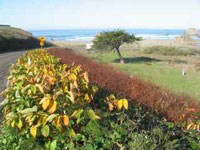 The Knotweed Removal project came about after watching the invasive Giant Knotweed grow from a patch 10 feet square to 40′ x 120′ in just a few years. The knotweed covered a hillside at Seaside Meadow and crowded out every other plant, becoming a monoculture with little habitat value for the native plants and animals. We received grants and assistance from partners to remove the patch, the only sighting in Mendocino County.
The Knotweed Removal project came about after watching the invasive Giant Knotweed grow from a patch 10 feet square to 40′ x 120′ in just a few years. The knotweed covered a hillside at Seaside Meadow and crowded out every other plant, becoming a monoculture with little habitat value for the native plants and animals. We received grants and assistance from partners to remove the patch, the only sighting in Mendocino County.
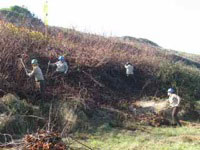 Initially, the Civilian Conservation Corps cut most of the above ground foliage and burned it on-site. Knotweed is very invasive and spreads easily from its rhizomes; even a small part of root can sprout and start a new plant.
Initially, the Civilian Conservation Corps cut most of the above ground foliage and burned it on-site. Knotweed is very invasive and spreads easily from its rhizomes; even a small part of root can sprout and start a new plant.
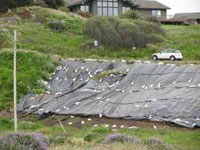 The Corps members also helped us roll out a huge tarp that would cover all of the root mass for two winters. The edges of the tarp were buried a foot deep to keep the roots from traveling underground to sprout outside the covered area. The tarp had to be weighted down with sandbags to keep the strong northwest winds from ripping it off. After 1.5 years, we were ready to tackle the root removal.
The Corps members also helped us roll out a huge tarp that would cover all of the root mass for two winters. The edges of the tarp were buried a foot deep to keep the roots from traveling underground to sprout outside the covered area. The tarp had to be weighted down with sandbags to keep the strong northwest winds from ripping it off. After 1.5 years, we were ready to tackle the root removal.
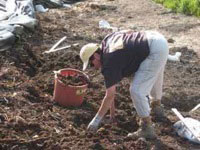 When the tarp was pealed back, it became obvious that the knotweed rhizomes were severely depleted. Only weak sprouts showed where a bit of sunshine had made its way through holes in the tarp.
When the tarp was pealed back, it became obvious that the knotweed rhizomes were severely depleted. Only weak sprouts showed where a bit of sunshine had made its way through holes in the tarp.
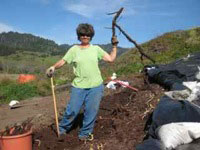 A standing crew of three workers tackled the root removal, supplemented by the CCC crew as the project progressed. The pulled roots were set in the sun to dry and eventually burned.
A standing crew of three workers tackled the root removal, supplemented by the CCC crew as the project progressed. The pulled roots were set in the sun to dry and eventually burned.
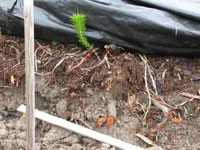 Long hours of root-digging were rewarded by the lack of knotweed among the newer sprouts of native plants (and some benign exotics) that filled the bare ground immediately.
Long hours of root-digging were rewarded by the lack of knotweed among the newer sprouts of native plants (and some benign exotics) that filled the bare ground immediately.
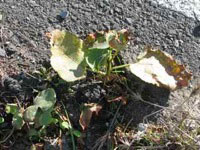 A few of the knotweed plants remained along the highway, where we couldn’t dig thorough the asphalt. These were then injected with herbicide by the Mendocino County Agriculture Dept and died in a couple of weeks.
A few of the knotweed plants remained along the highway, where we couldn’t dig thorough the asphalt. These were then injected with herbicide by the Mendocino County Agriculture Dept and died in a couple of weeks.
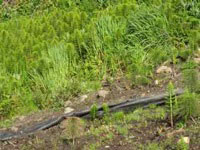 CoLT is proud to have a successful knotweed removal project with a minimum of herbicide, and the slope remains knotweed-free.
CoLT is proud to have a successful knotweed removal project with a minimum of herbicide, and the slope remains knotweed-free.